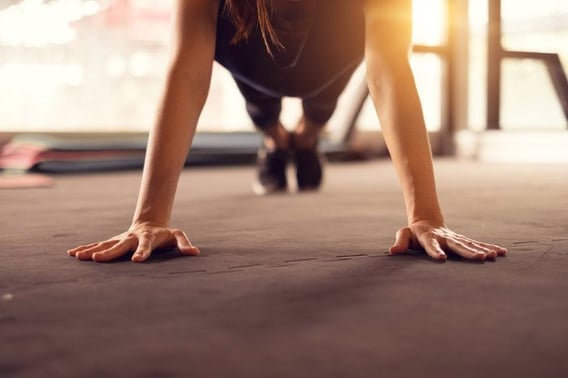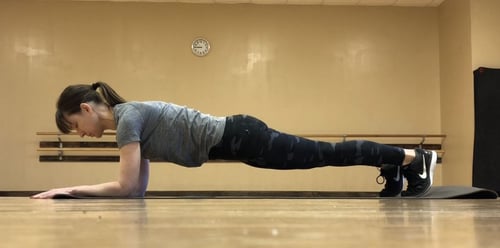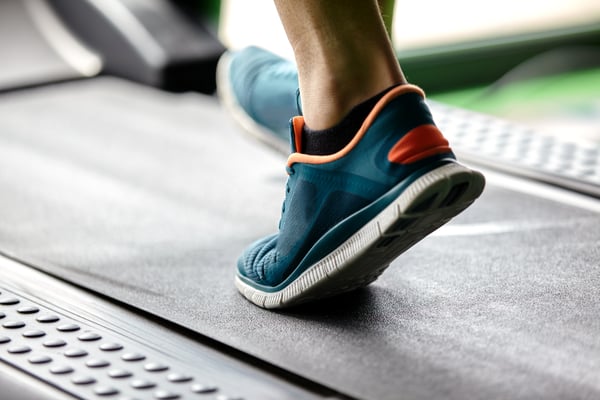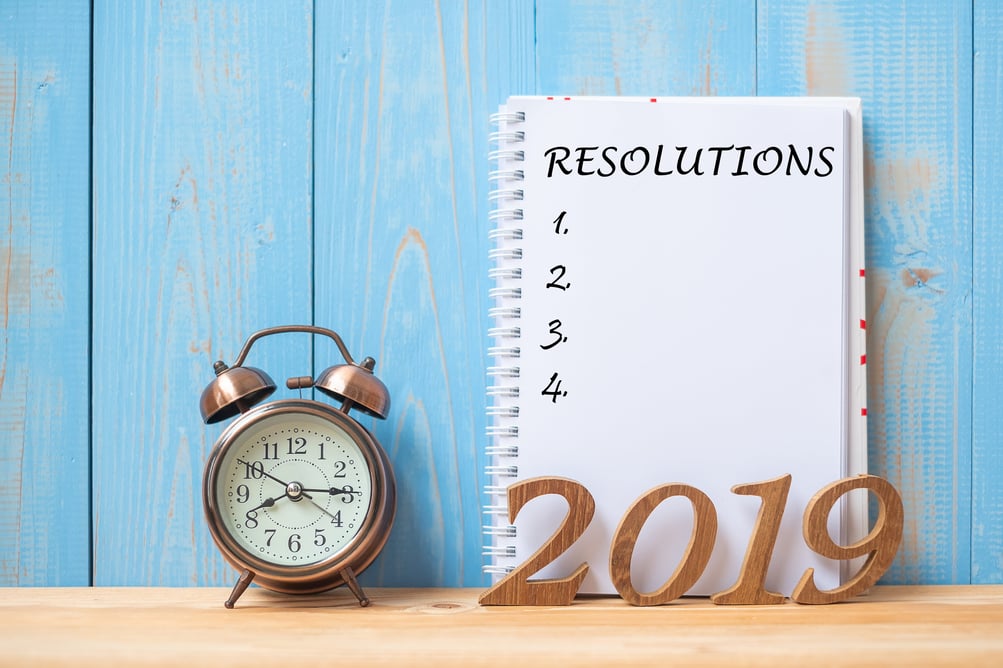How to engage your core! What does that even mean?

Have you ever heard a trainer or group exercise instructor say “engage your core” or “tighten your abs”? Some might cue you to pull your navel to your spine. These are all ways to remind you to tighten your abdominal muscles while performing certain exercises so you can reap the most benefit from the moves as well as reduce your risk of injury. But how do you do it? What does it even mean?
First, a quick look at what makes up your abdominal muscles (abs) which are a big part of your core. Everyone has four layers of abs. The deepest layer is called the transversus abdominis (TVA). The TVA wraps around your waist to connect the ribcage to the pelvis. On top of the TVA are the internal and external obliques which criss-cross your torso. Last but not least, the top layer is your rectus abdominis which are the muscles that form that often discussed six-pack. When all four of these ab muscles are braced together, working with the muscles that line your spine, you have what is called an engaged core. Keep in mind, your core also includes your glute muscles and adductor muscles in your hips along with your lower back and abs.
Why do you want to engage your core? Engaging your core during your workout helps reduce the risk of injury, especially injuries of the lower back. For example, think about completing shoulder presses. As your shoulders get tired you may start arching your lower back which puts a dangerous strain on your spine and the muscles around it. By zipping up your abs and squeezing your glutes, your spine is more protected and you can move your shoulders through a safer range of motion.
Practice engaging your core while doing my fast ab circuit!
Also, engaging your core when performing abdominal exercises especially, ensures your abs are doing the work instead of recruiting other muscles to take over. This will make those moves more effective. Since your core is the basis of almost every movement we make in our day to day lives, it is important to keep it strong.
So how do you engage your core? Your abs should be tight and pulling in but you should be able to breathe and move normally. It is NOT sucking in your stomach and holding your breath. You can practice engaging your core at any time by feeling your ribs expand to the sides while you inhale, then as you exhale contract and zip up your abs, thinking about pulling your navel up and in toward your spine. Keep breathing normally while you continue to hold your abs in.
Keeping your core engaged properly while exercising will help keep your core strong and reduce your risk of injury not only while working out, but also in your day to day activities.
Look for more great core exercises? Check out our staffs favorite ab workouts!
Topics: LivRite News
Are you looking to strengthen your abdominals? Whether you want to have a six-pack or improve your balance, there are many reasons to strengthen your stomach muscles and the other muscles around your mid-section that make up your core. Your core muscles are used in just about every movement you make so it is important to keep them strong. If you have extra around your middle, check out my post with 5 tips to lose belly fat.
Here is a fast circuit workout for your core. These are exercises you can do at home or at the gym.
Set your timer for 30 seconds. You'll do each move for 30 seconds, rest for 10 seconds in between each. Rest for a minute then repeat all three exercises two more times.
Here is a basic explanation of each move:
Scissors - Lie flat on your back. You can extend your arms along the sides of your body with your palms pressing into the floor, or you can bend your elbows and place your palms under the back of your head. Pull your navel in towards your spine (engaging your abs) and actively press your lower back flat on the ground. Lift both legs straight up toward the ceiling, continuing to engage your abs and press your lower back into the ground throughout the exercise. Slowly lower your right leg down toward the ground, until it is a few inches above the floor. Then scissor your legs, so you lift your right leg back up as you lower your left leg down towards the ground. Keep this up with slow and controlled movements.
Russian Twist - Sit with your knees bent and heels on the floor. Engage your abs and lean back until your upper body is at a 45 degree angle to the floor, keeping your back long and flat. Rotate your torso, reaching both hands toward the floor on the side before returning back to center then reaching for the other side. A weight or medicine ball can be held and/or feet lifted off the ground to make this more challenging.

Plank - Lie facedown with legs extended and elbows bent and directly under shoulders; place your hands flat. Feet should be hip-width apart, and elbows should be shoulder-width apart. Contract your abs, then tuck your toes to lift your body (forearms remain on the ground); you should be in a straight line from head to heels. Hold for 30 seconds.
Do this two to three times a week on non-consecutive days for stronger abs!
Looking for more great ab exercises? Take a look at our full list of ab workouts.
Topics: LivRite News, Workouts

Ready to start exercising? Great! Physical activity benefits your physical and mental health in so many ways, it should be an important part of your lifestyle. However, there is so much information out there, and our lives or so busy already, it can seem overwhelming to begin. It doesn’t have to be so complicated or take up that much time. Whether you are getting back to working out after some time off, or are beginning an exercise habit for the first time, here are some things to keep in mind as you get started.
Four Workout Tips for Beginners
1. Get Physical – a physical that is. You might need an actual physical from your doctor before you start exercising. Anyone with major health issues or health risks should get clearance from their doctor prior to beginning any exercise routine. No matter your medical condition, you can probably workout in some way. But it’s best to get those details and any restrictions from your doctor.
2. Set A Goal – What is your workout goal? Do you want to run a 5k? Lower your blood pressure? Hold a plank for a minute? Think of goals that are specific and measurable that you can work toward and achieve in a shorter period of time. For example, instead of saying a large overarching goal like “workout more” or “lose 100 pounds”, make a starting more specific goal of exercising twice a week.
3. Start Slow – Starting out too aggressively may result in injury. Doing too much too soon is not good for your body and will not provide instant results. Exercise should be a lifelong habit so it should be sustainable and something you can stick with. Slowly progress the time you exercise and the weight you use.
4. Plan a Balanced Routine – a good exercise routine will contain some cardiovascular activity, strength conditioning and stretching.
- When starting out with cardiovascular activity like walking, running or the elliptical, shoot for 20-30 minutes at a pace where you can carry on a conversation if you had to but couldn’t sing a song. If you can sing, you aren’t going fast enough. For heart health, the American Heart Association recommends 30 minutes of moderate intensity physical activity on most days of the week. According to the CDC, moderate intensity means your heart rate should be between 50% - 70% of your maximum heart rate. An approximate way to calculate your maximum heart rate is to subtract your age from 220.
- Strength conditioning should be done at least twice a week. Start with working each major muscle group with a weight that you can lift for 10-12 repetitions with the last reps being very difficult. Don’t work the same muscle group on consecutive days and be sure to warm up with a 5 minute walk or other dynamic activity prior to strength training.
- Stretching should be done after each workout. Static stretches for each major muscle group should be held for 10-30 seconds.
Don’t be intimidated by all the information, all of the gym equipment or all the different ways to exercise! It can be as simple as adding walking 20-30 minutes to your day. Follow the tips above to get started. Want more information and to get a workout created especially for you? Contact a LivRite personal trainer today!
Topics: LivRite News

Looking for great upbeat Christian workout music? Sometimes it can seem overwhelming to find the right music or create the right playlist, but with apps like Apple music and Spotify it's never been easier to make playlists featuring upbeat christian workout songs. We had a lot of fun putting this playlist together, and finding music that motivates you for running or working out and really helps push you when your workout starts getting harder and you need to stay mentally strong to finish! The tempo and the beats are great, but even more some of the messages in these songs are exactly what you may need to hear to keep your workouts going, they sing about overcoming obstacles and doing hard things and keeping faith. They are really motivational songs that can help you stay the course and keep moving forward.
The following list is our top 8 christian workouts songs with great beats to listen to during your next workout. If you click on the song title you can listen on YouTube and if you Click here you can listen to this playlist on Spotify
8. Start Over (Flame feat. NF)
7. The Gospel (Bizzle)
6. Build Your Kingdom Here (The Rend Collective)
5. I'm Turnt (Lecrae)
4. Feel Invincible (Skillet)
3. Ooh ahh (Grits feat. Toby Mac)
2. God's Not Dead (Newsboys)
1. Coming in hot (Andy Mineo ft. Lecrae)
We really enjoy this playlist, what do you think of about it? Are some of these songs in your workout mix or do you have any Christian songs you would recommend we add to our playlist? We hope you found it helpful to have a playlist of clean, upbeat faith-filled music. Let us know on Facebook.
Topics: LivRite News

Making a New Year’s Resolution is a great way to make a positive change in your life. But unfortunately, according to U.S. News, approximately 80% of resolutions fail by February. How can you make a lasting change? To be successful at something you would like to achieve, it is important to make sure your resolutions are SMART.
SMART stands for Specific, Measurable, Attainable, Relevant and Time Bound.
- Specific For example, let's say you want to get healthier. Is that specific? Not really. What does being healthier mean to you? Be more specific. Do you want to lower your blood pressure? Get off Diabetes medication? Lose 20 pounds? A specific goal has a much greater chance of being accomplished than a general goal.
- Measurable Now that you have made the goal more specific, it should be easier to measure. Decide to track the goal per week or per month and decide the measures you will use to track. For example, if I want to lose 20 pounds, I will weigh myself once a week with a goal of losing 2 pounds per week. Keeping track of progress gives incentives to keep going.
- Attainable If you don't have the time, money or talent to reach a certain goal you'll fail and be miserable. In some cases of health or fitness resolutions, you may need to consult with your doctor to ensure it is a safe and/or realistic resolution. I heard of someone who resolved to read 75 books in a year. She didn't think about how much time that would actually take and with a full time job, a husband and child, that goal really wasn't realistic for her. However, that doesn't mean that you can't try for something that might sound impossible and make it happen by planning smartly and going for it!
- Relevant Is the resolution something that is important to you? Why do you want to make this change? Goals are more likely to be reached if they are significant to you.
- Time Bound Goals need to have a time limit or date to be reached to help keep you motivated and to establish a sense of urgency to prevent life from getting in the way. Also, if you have a big goal, like losing weight, making small specific goals toward that big objective will be motivating and keep you going. When my resolution was to run a half marathon, the mini marathon training schedule provided built in smaller goals along the way. In the months leading to the mini, having a 5k and 10k set up on specific dates (that I registered and paid for which really helped with accountability!) kept me on track toward the bigger goal of the half marathon and gave me the satisfaction of meeting those achievements as well. Having a deadline or set date makes it more likely it will happen.
Instead of vague resolutions, SMART goal setting creates a set path towards your objective. Every goal or resolution can be made SMART and then will be closer to reality.
Need help with your health and fitness resolution? Schedule a Fitness Assessment with a LivRite trainer today!
Topics: LivRite News


